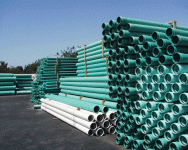bigtiller
Super Member
- Joined
- Feb 1, 2006
- Messages
- 6,467
- Location
- central Iowa
- Tractor
- John Deere 2720 John Deere 3039R John Deere Z545R
A relative did something similar years ago. He buried two 8" non-perforated tiles in a 6 foot deep ditch that was 100 feet long. The ditch made a loop from the north wall to the east wall and up through the floor into his shop. On one end he fit a squirrel fan powered with a quarter horse power electric motor.
The tiles started leaking after about a month, then the mice and moles started eating more holes into them.
It was a great idea but he couldn't keep the tiles dry and every time he turned it on, the shop had a musty smell. So I would advise you use a high quality pipe and seal it tight.
The tiles started leaking after about a month, then the mice and moles started eating more holes into them.
It was a great idea but he couldn't keep the tiles dry and every time he turned it on, the shop had a musty smell. So I would advise you use a high quality pipe and seal it tight.

